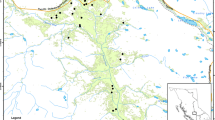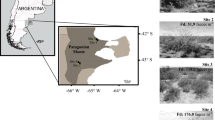Abstract
The effects of different intensities of cattle grazing on theaboveground growth, reproduction, and abundances of three palatable forbs werestudied in native tallgrass prairie. Populations of Asterericoides, Ruellia humilis, andAmorpha canescens were sampled at peak flowering duringthe1993–1995 growing seasons in four annually-burned sites varying incattle stocking density [ungrazed, low, moderate, high]. The threeforbs exhibited reduced shoot growth and/or reproduction under moderate toheavy grazing, and in no case did grazing increase any measure of plantperformance. Ruellia showed reduced shoot height andbiomass, percentage of stems flowering, and reproductive biomass in response tograzing. Aster showed decreases in shoot biomass andheightwith grazing. Amorpha showed no change in shoot orreproductive biomass, but a decrease in percent of flowering stems and inreproductive allocation with grazing. Patterns in the percentage of stemsgrazedindicated generally high but variable palatability among these species. Bycontrast, the three species showed inconsistent population response to grazing.Abundance (frequency) of all three species indicated no short-term changebetween years in response to grazing intensity. Responses of these speciesdiffer considerably from those of most other perennial tallgrass prairie forbsthat are unpalatable, unconsumed, and increase in performance (e.g. size,abundance) due to release from competition from the dominant grasses underungulate grazing. The results demonstrate that immediate aboveground growth andreproductive responses of established adults to grazing are not good predictorsof grazer effects on population abundances in tallgrass prairie.
Similar content being viewed by others
References
Axelrod D.I. 1985. Rise of the grassland biome, central North America. Botanical Review 51: 163–201.
Belsky A.J. 1986. Does herbivory benefit plants? A review of the evidence. American Naturalist 127: 870–92.
Bergelson J. and Crawley M. 1992. Herbivory and Ipomopsis aggregata: the disadvantage of being eaten. American Naturalist 139: 870–882.
Brewer J.S. and Platt W.J. 1994. Effects of fire season and herbivory on reproductive success in a clonal forb, Pityopsis graminifolia. Journal of Ecology 82: 665–675.
Collins S.L. 1987. Interactions of disturbance in tallgrass prairie: a field experiment. Ecology 68: 1243–1250.
Collins S.L. and Glenn S.M. 1991. Importance of spatial and temporal dynamics in species regional abundance and distribution. Ecology 72: 654–664.
Collins S.L., Knapp A.K., Briggs J.M., Blair J.M. and Steinauer E.M. 1998. Modulation of diversity by grazing and mowing in native tallgrass prairie. Science 280: 745–746.
Connell J.H. 1978. Diversity in tropical rain forests and coral reefs. Science 199: 1302–1310.
Crawley M.J. 1988. Herbivores and plant population dynamics. In: Davy A.J., Hutchings M.J. and Watkinson A.K. (eds), Plant population ecology. 28th Symposium of the British Ecological Society., pp. 367–392.
Damhoureyeh S.A. and Hartnett D.C. 1997. Effects of bison and cattle on growth, reproduction, and abundances of five tallgrass prairie forbs. American Journal of Botany 84: 1719–1728.
Dirzo R. 1984. Herbivory: a phytocentric overview. In: Dirzo R. and Sarukhan J. (eds), Perspectives on plant population ecology. Sinauer Associates, Sunderland, MA, pp. 141–165.
Dwyer D.D. 1961. Activities and grazing preferences of cows with calves in Northern Osage County, Oklahoma. Oklahoma Agricultural Experiment Station, Bulletin B-588.
Evans E.W. 1988. Grasshopper (Insecta: Orthoptera: Acrididae) assemblages of tallgrass prairie: influences of fire frequency, topography, and vegetation. Canadian Journal of Zoology 66: 1495–1501.
Fahnestock J.T. and Knapp A.K. 1994. Plant responses to selective grazing by bison: interactions between light, herbivory and water stress. Vegetatio 115: 123–131.
Great Plains Flora Association 1986. Flora of the Great Plains. University Press of Kansas, Lawrence, KS.
Hartnett D.C. and Keeler K.H. 1995. Population processes. In: Joern A. and Keeler K.H. (eds), The changing prairie: North American Grasslands. Oxford University Press, pp. 82–99.
Hartnett D.C., Hickman K.R. and Fischer-Walter L.E. 1996. Effects of bison grazing, fire, and topography on floristic diversity in tallgrass prairie. Journal of Range Management 49: 413–420.
Hartnett D.C. and Fay P. 1998. Plant populations: patterns and processes. In: Knapp A.K., Briggs J.M., Hartnett D.C. and Collins S.L. (eds), Grassland dynamics: long term ecological research in tallgrass prairie. Oxford University Press, pp. 81–100.
Hendrix S.D. 1988. Herbivory and its impact on plant reproduction. In: Doust J.L. and Doust L.L. (eds), Plant reproductive ecology: patterns and strategies. Oxford University Press, pp. 246–263.
Herbel C.H. and Anderson K.L. 1959. Response of True Prairie vegetation on major Flint Hills range sites to grazing treatment. Ecological Monographs 29: 171–186.
Herms D.A. and Mattson W.J. 1992. The dilemma of plants: to grow or defend. Quarterly Review of Biology 67: 283–335.
Hickman K.R. 1996. Effects of large ungulate herbivory on tallgrass prairie plant population and community structure.
Hickman K.R., Hartnett D.C. and Cochran R.C. 1996. Effects of grazing Systems and stocking rates on plant species diversity in Kansas tallgrass prairie. In: West N.E. (ed.), Proceedings Fifth International Rangelands Congress. Society for Range Management, Denver, pp. 228–229.
Kothmann M.M. and Kallah M.S. 1978. Phenology, carbohydrate reserves and nutrient content of heath aster. Southwest Naturalist 23: 347–362.
Kucera C.L. 1956. Grazing effects on composition of virgin prairie in North-central Missouri. Ecology 37: 389–391.
Launchbaugh J.L. and Owensby C.E. 1978. Kansas rangelands: their management based on a half century of research. In: Kansas Agricultural Experiment Station Bulletin No. 622.
McNaughton S.L. 1977. Diversity and stability of ecological communities: a comment on the role of empiricism in ecology. American Naturalist 111: 515–525.
McNaughton S.L. 1983. Compensatory plant growth as a response to herbivory. Oikos 40: 329–336.
Milchunas D.G., Sala O.E. and Lauenroth W.K. 1988. A generalized model of the effects of grazing by large herbivores on grassland community structure. American Naturalist 132: 87–106.
Owensby C.E. 1973. Modified step-point system for botanical composition and basal cover estimates. Journal of Range Manage 26: 302–303.
Paige K.N. and Whitham T.G. 1987. Overcompensation in response to mammalian herbivory: the advantage of being eaten. American Naturalist 129: 407–416.
Pfeiffer K.E. and Hartnett D.C. 1995. Bison selectivity and grazing response of little bluestem in tallgrass prairie. Journal of Range Management 48: 26–31.
SAS Institute 1989. SAS/STAT user's guide. Version 6. SAS Institute, INC., Cary, NC.
van der Meijden E., Wijn M. and ver Kaar H.J. 1988. Defense and regrowth, alternative plant strategies in the struggle against herbivores. Oikos 51: 355–363.
Vinton M.A. and Hartnett D.C. 1992. Effects of bison grazing on Andropogon gerardii and Panicum virgatum in burned and unburned tallgrass prairie. Oecologia 90: 374–382.
Weaver J.E. 1968. Prairie plants and their environment: a fifty-year study in the Midwest. University of Nebraska Press, Lincoln, NE.
Author information
Authors and Affiliations
Rights and permissions
About this article
Cite this article
Hickman, K.R., Hartnett, D.C. Effects of grazing intensity on growth, reproduction, and abundance of three palatable forbs in Kansas tallgrass prairie. Plant Ecology 159, 23–33 (2002). https://doi.org/10.1023/A:1015534721939
Issue Date:
DOI: https://doi.org/10.1023/A:1015534721939




